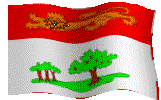





The crescent-shaped island is 224 km in length and ranges in width from 6 - 64 km, giving it a total area of 5660 km2. It lies in the Gulf of St. Lawrence, separated from Nova Scotia and New Brunswick by Northumberland Strait. Its highest point is 152 m above sea level. The province has numerous lakes and rivers, most of which are quite small.
Rich soil and a temperate climate make Prince Edward Island an ideal place for mixed farming. Half of its land is under cultivation, earning it the nickname "the Garden Province." It is renowned for its red soil, sand dunes and 800 km of beaches.
The Europeans discovered the island when Jacques Cartier landed there in 1534; he described it as "the most beautiful stretch of land imaginable." In spite of his enthusiastic description, it was a long time before the island was settled. No permanent colony existed until the French established one in 1719; 30 years later, the population numbered a mere 700.
The population of the island multiplied after the British deported the Acadians from Nova Scotia in 1755. By the time Louisbourg fell to the British in 1758, the island's population had risen to 5000.
In 1766, Captain Samuel Holland prepared a topographic map of the island, then known as the Island of Saint John, dividing it into 67 parcels of land and distributing it by lot to a group of British landowners. The absentee landlords, many of whom never set foot on the island, gave rise to numerous problems. Some refused to sell their lands to their tenants, while others demanded exorbitant purchase or rental prices.
In 1769, the Island of Saint John became a separate colony, and in 1799 it was given its present name, in honour of Prince Edward of England.
Prince Edward Island is known as the cradle of Confederation, since Charlottetown, its capital, was the site of the 1864 conference that set Canadian Confederation in motion. This distinction notwithstanding, the island waited until 1873 to join the Dominion of Canada.
Approximately 80% of the people are of British (mainly Scottish and Irish) origin. About 15% are of French origin, and five percent speak French.
The island population is quite young - about 38% of the people are under 25.
Prince Edward Island's rich, red soil is ideal for growing potatoes, which are the most important source of income for the province's farms.
Although lobster is king of the waters off Prince Edward Island, about 30 other fish and seafood species are caught, notably cultivated mussels, herring, bluefin tuna and the renowned Malpeque oysters.
Finally, the island's 800 km of beaches attract over 665,000 visitors yearly for relaxation and water sports, including bluefin tuna fishing.


